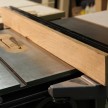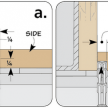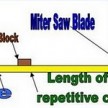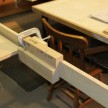Fast Rabbet Cuts
Fast Rabbet Cuts
In the woodworking and finish carpentry world a rabbet joint is a recess, channel or groove cut into the edge of a piece of wood. A rabbet is a simple joint to make, and increases gluing surfaces for a strong glue joint. Rabbets also assist with alignment for adjoining boards and provide a stronger mechanical joint than a butt joint.
A rabbet is simply an open-sided channel or recess along the edge or across the end of a board or panel. Easy to cut, it helps locate parts during assembly, and it provides more of a mechanical connection than does a butt joint.
Making Rabbet Cuts:
Typically the easiest way to cut a rabbet is with a stacked dado head cutting set on a tables saw. Some folks use a router table and a straight bit, but a table saw is raster.
In my shop, instead of trying to bet my dado blade perfect I simply use a sacrificial strip of wood is attached to my existing table saw fence. Using the sacrificial fence protects my everyday use table saw fence.
Consider the thickness of the material that will receive the rabbet. Typically you want to achieve 1/3 thickness. [ E.g., 3/4-inch material the rabbet should be ¼-inch]
When To Use a Rabbet Joint
Rabbets can be used to make a number of joinery project including:
□ Custom cabinet cases
□ Face frames
□ Bead board
□ Wainscoting
□ Shelving
□ Simple drawers
□ Boxes
□ Mirror frames
□ Setting back panels onto bookcases and cabinets
Using an Auxiliary Fence to Cut the Rabbet
1. Select scrap stock for an auxiliary fence. This stock can be 2×4 or 1×4 stock and should be approximately, the same length as your existing fence.
2. Attach an auxiliary fence to your table saw fence with screws or clamps. Avoid placing screws in the area of the blade.
3. Attach your dado blade, having the blade wider than the desired rabbet is preferred.
4. Lower the Dado blade and move the auxiliary fence over the dado blade or partially over it.
5. Check that the dado set will only cut the auxiliary fence and not the rip fence.
6. Lock down fence.
7. Start machine and slowly raise the blade to cut into the auxiliary fence to cut in a recess in the auxiliary fence.
8. Stop machine, check and adjust the blade height
9. Adjust the table saw fence to the width of your desired rabbet cut.
10. Move fence towards or away from the blade to make adjustments on your rabbet cut.
11. Make cut.










